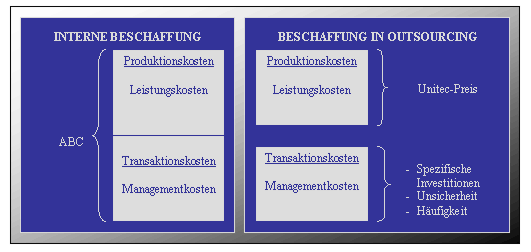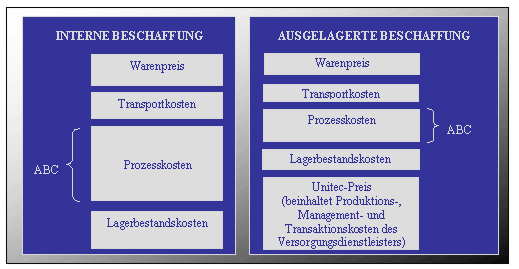This page has been automatically translate with Google from the German language.
3 Theoretical model for the analysis outsourcing of the Procurement
3.3 From production and transaction costs to total costs
In chapter 3.1 the terms "production costs" and "transaction costs" were already defined.
While production costs are the costs, which develop for the contracting parties for the production of the goods or achievements which can be exchanged, the transaction costs represent the costs, which result for the completion and organization of the exchange. Since the procurement is seen as transaction, production costs result from the sum of the costs of the production of the procurement activities, while the transaction costs from the organization and the management of the whole of these activities develop.
In the case production costs correspond to the enterprise-internal procurement to the costs of the pure procurement achievement and the transaction-cost the costs of the organization of this achievement. During the paged out procurement however places the price, that the enterprise to the external service supplying company (here: Unitec) pays, production costs. While the costs of the management of the contractual relation with the service supplying company the transaction costs correspond.
Since the quantification of these costs is however difficult, the transaction dimensions defined in the transaction cost theory should facilitate the cost calculation.
The following illustration summarizes this interpretation:

Fig. 8: The cost registration in the procurement according to the transaction cost theory
In practice it is not easy to consider the separation between production and transaction costs as the contribution of the-set 93 shows, that however the terms of the transaction cost theory differently used. The distinction between production and transaction costs remains, but under transaction costs it understands the costs of the organization of the resources exchange only regarding the market situation. The costs of the exchange organization within an enterprise are defined however as management costs.
The-set criticizes the past transaction-cost-theory-referred studies, which examine the organization form decision on basis of the simple comparison between transaction costs and management costs.
That the hierarchical organization form is to replace the market, if the transaction costs are higher than the management costs, is an inaccurate statement.
The separation between "Make or Buy" is not clear and leads therefore to unidentified problems. 94
The own position of a product requires the purchase of inputs on the market, so that transaction costs play their role also in the Make decision.
Exactly the same management costs in the Buy decision emerge, since the paid product price contains not only production costs but also the management costs of the manufacturer.
Therefore both transaction costs and management costs in both organization forms are to be regarded and one make the correct decision, if that organization form is selected, those the lowest sum of transaction -, management and production costs possesses.
Enterprises buy products, if this is more economical, as their internal production. This does not mean that the market solution is more economical, if the transaction costs are lower than the management costs.
That would be a wrong conclusion of the existing studies, which do not consider the important role of production costs. 94
Assumed the transaction costs amount to zero and the management costs are positive, then the own position can be nevertheless more favorable, if e.g. production costs and thus the product price of the other manufacturer are too high. On the other side the purchase can be more favourable in the market also with management costs of zero, if e.g. production costs of the other manufacturer are low enough.
The fact that these circumstances remain often unconsidered lies in the implicit acceptance that information is perfect and free.
The transaction cost theory recognizes the information costs regarding the transaction and management activities,
but not regarding production activities.
Thus it is accepted that each enterprise can manufacture a product directly well
and efficiently, so that the production costs differences may not play a role in the Make or Buy decision. 96
Each enterprise is however a complex bundle of technology, personnel and methods within a firm specific information bowl. This bundle cannot be changed or imitated mostly fast or simply. 97
In the final result the force of expression of the transaction cost theory is in our ability to make it applicable mathematically calculable and on concrete problems. This is difficult to reach.
It is complicated, the relevance of the transactions - to discuss the management and production costs without a clear distinction between them since no clear distinction is given. 98
Therefore in this work the enterprise-internal is compared with the paged out procurement on the basis the sum of the entire costs. The total costs of the procurement contain both production and management and transaction costs and result from the sum of the cost factors commodity price, transport costs, process costs and stock costs, which are to be regarded also with outsourcing.
Even the process costs, which are determined by means of ABC, are a component of the total costs in the paged out procurement, there some process activities (complete or partial) remain internally preserved.
In the case outsourcing must pay the enterprise additionally a price of the Unitec for the procurement service.
This price contains again productions -, the management and the transaction costs, now however those from Unitec.
The model for the comparison of the two possible organization forms, i.e. internal and paged out procurement, looks thus as follows:

Fig. 9: Model to the cost comparison between the enterprise-internal and the paged out procurement.
All these aspects of cost are thus relevant for an outsourcing decision.
"(...) most enterprises are limited however
with one another to compare the sums of commodity price and transport costs in order to judge the pro and cons outsourcing
of the procurement. The organizational cost factors, i.e. process costs, stock costs and if necessary.
For supplying service border RPR ice, remain however in many investigations unconsidered, also, because they are to be determined
many more with difficulty and more time-consuming." 99
Therefore the work concentrates on the determination of the organizational cost factors.
Nevertheless the effects outsourcing at the other cost expense in chapter 4.2.2 are mentioned, in order to ensure as perfect an
analysis of procurement costs as possible.
93 Vgl. The-set (1993).
94 Vgl. The-set (1993), P. 162.
95 Vgl. The-set (1993), P. 163.
96 Riordan/Williamson (1985) agree with the fact that both production and the transaction costs of the organization form decision are applicable. Nevertheless they that the qualitative prognoses of the transaction cost theory remain unchanged in nearly all cases, show indipendent whether production costs are constant or are introduced production costs differences.
97 Vgl. The-set (1993), P. 163.
98 Vgl. The-set (1993), P. 163.
99 Marino V.: Interview, P. xxi xxii.
3. 4 summary
From the concepts described in this chapter results a theoretical model, which regards the
transactions and their characteristics as starting point for an optimal organization form decision.
The preparation on intended factors and conditions as well as for unexpected circumstances is crucial for the success of all
enterprises.
To that extent the transaction cost theory makes possible a qualitative investigation also for the decision of the most
efficient procurement organization form and can the existence and role outsourcing of the procurement explain.
For a quantitative analysis also the ABC beginning is necessary, since it is a suitable instrument for the determination
of the process costs. Thus one can accomplish a decision-support cost comparison, which can be helpful for each enterprise for the reaching of the principal purpose cost minimizing.
This page has been automatically translate with Google from the German language.


